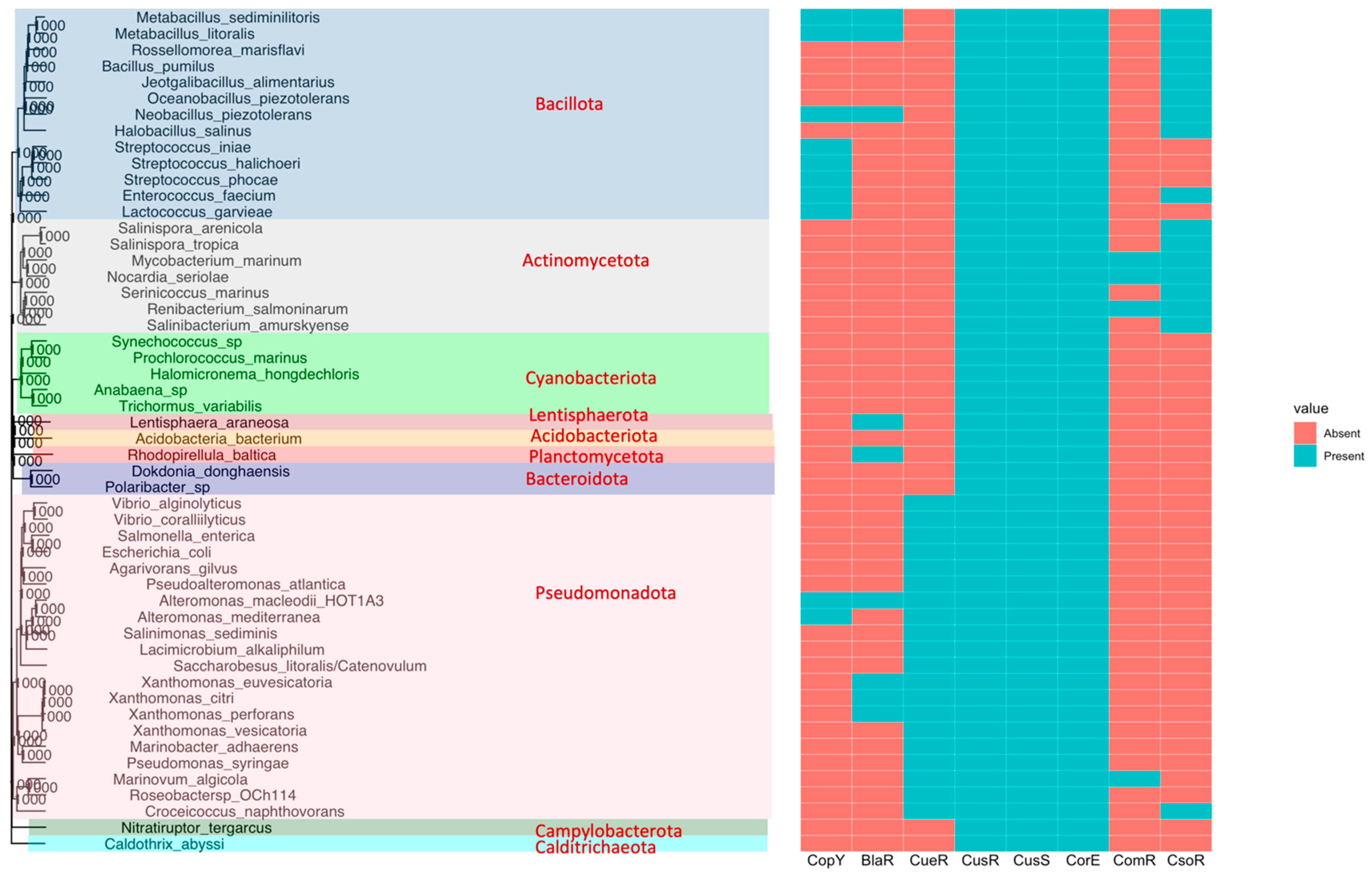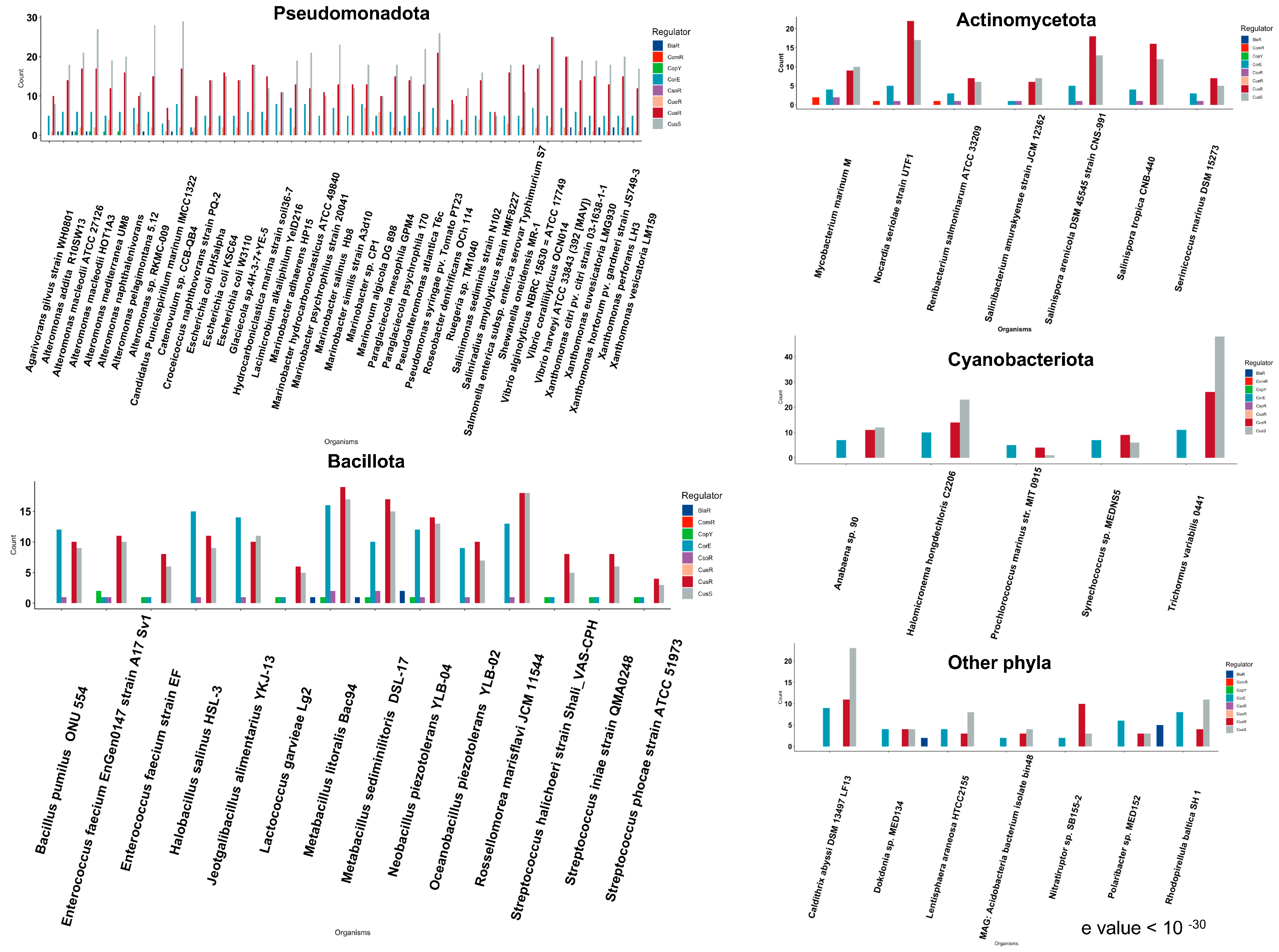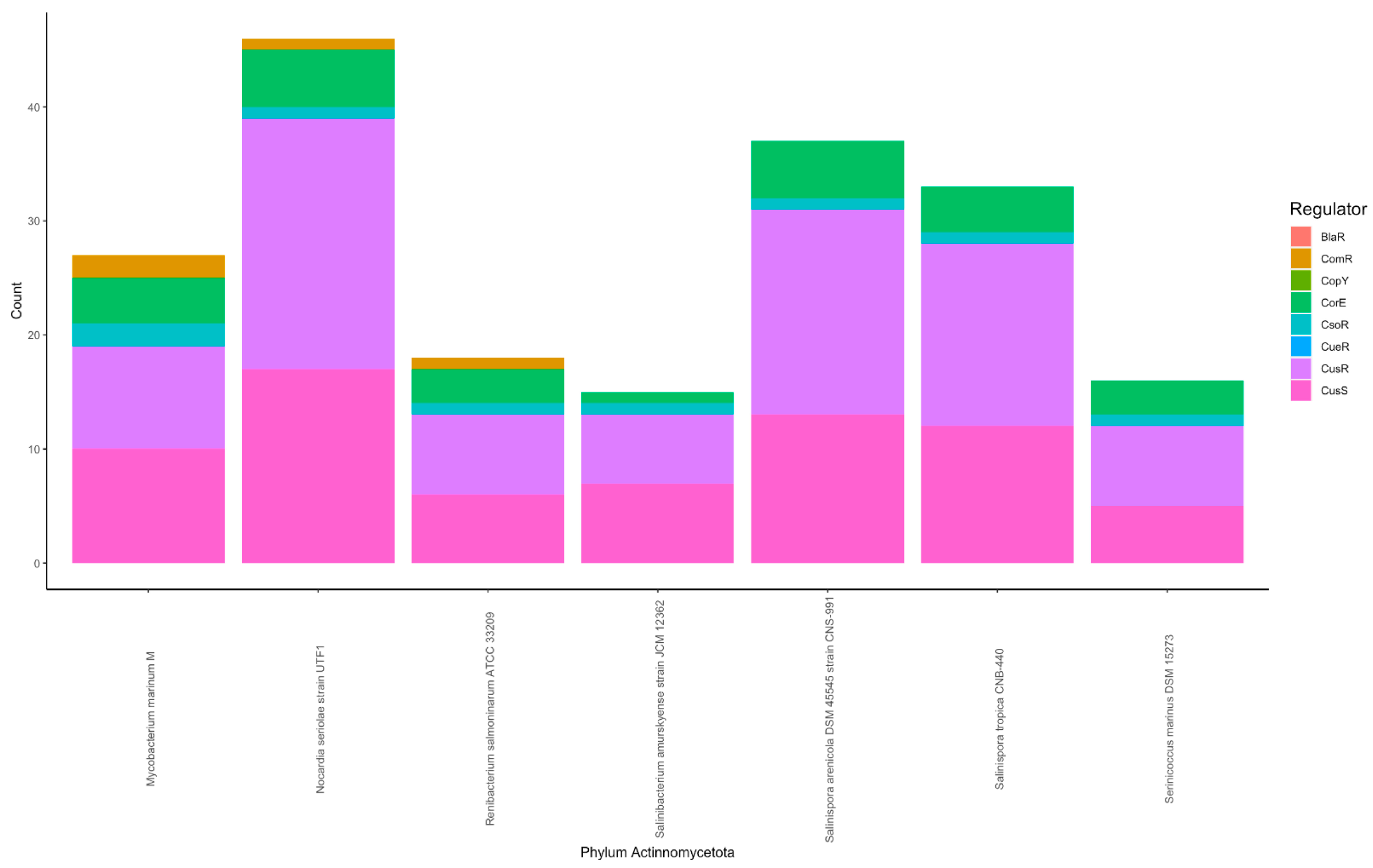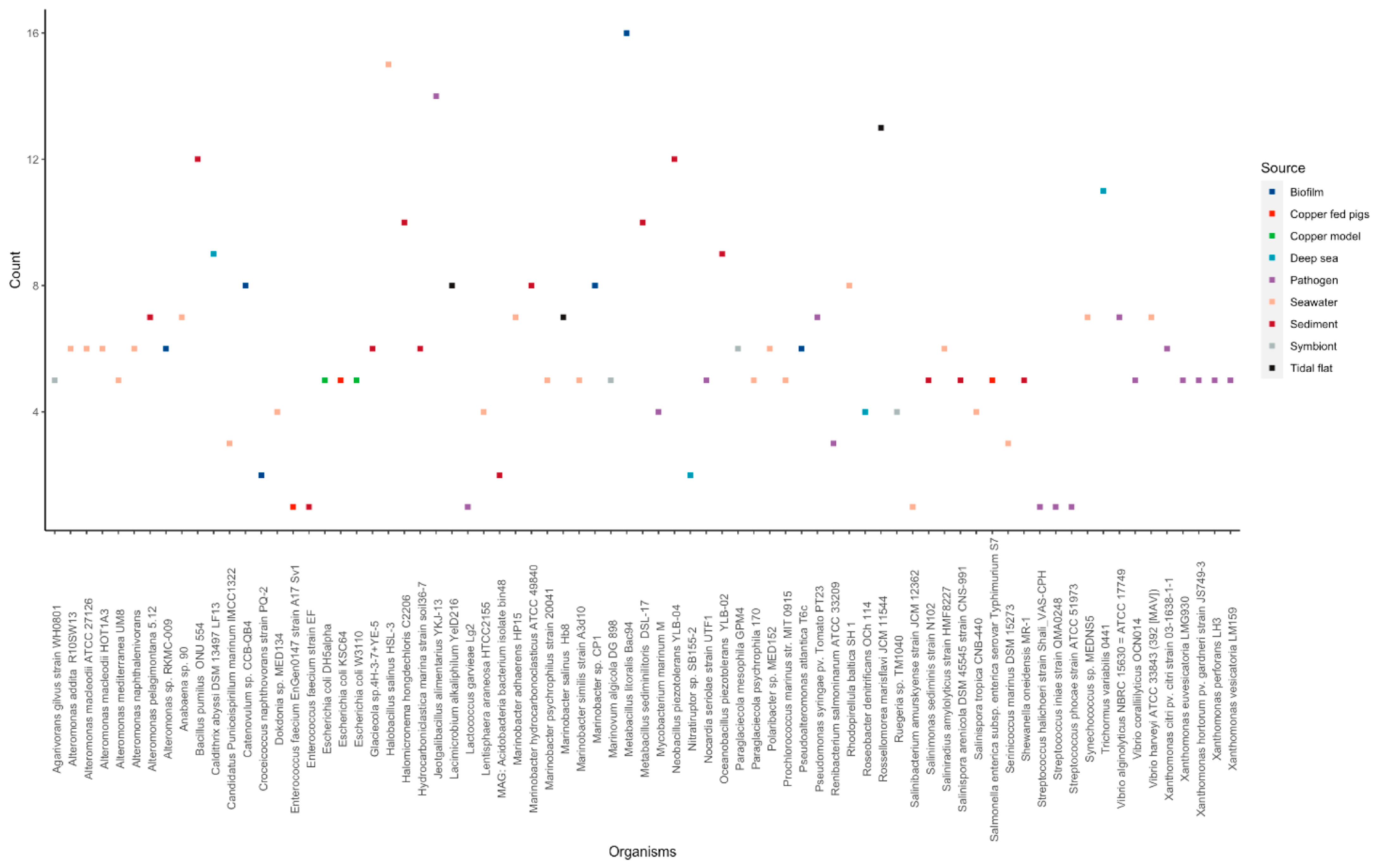Linking Copper-Associated Signal Transduction Systems with Their Environment in Marine Bacteria
Abstract
:1. Introduction
1.1. Bacterial Signal Transduction System Overview
1.2. Signal Transduction Systems Associated with Copper
1.2.1. One-Component Signal Transduction Systems of Copper Sensing
- I
- MerR Family Regulators of Copper
- II
- CopY Family Regulators of Copper
- III
- CsoR/RcnR Family Regulators of Cu
- IV
- ArsR/SmtB Family Regulator of Copper
- V
- TetR Family Regulator of Copper
1.2.2. Two-Component Signal Transduction Systems of Copper Homeostasis
1.2.3. Extracytoplasmic Function (ECF) σ Factor of Copper Homeostasis
2. Materials and Methods
Identification and Comparative Genomics of Copper-Associated Signal Transduction Protein Homologs
3. Results
3.1. Copper-Associated Signal Transduction System Homologs across Marine Bacteria and the Influence of Environment
3.1.1. Pseudomonadota Phylum
3.1.2. Cyanobacteriota Phylum
3.1.3. Other Phyla
3.1.4. Actinomycetota Phylum
3.1.5. Bacillota Phylum
3.2. Potential Role in Host–Pathogen Interaction of the One-Component Signal Transduction System ComR
3.3. ECF σ Factor CorE in Marine Bacteria and Its Potential Role
Supplementary Materials
Author Contributions
Funding
Data Availability Statement
Conflicts of Interest
References
- Ma, Z.; Jacobsen, F.E.; Giedroc, D.P. Coordination Chemistry of Bacterial Metal Transport and Sensing. Chem. Rev. 2009, 109, 4644–4681. [Google Scholar] [CrossRef] [PubMed] [Green Version]
- Malatesta, F.; Antonini, G.; Sarti, P.; Brunori, M. Structure and function of a molecular machine: Cytochrome coxidase. Biophys. Chem. 1995, 54, 1–33. [Google Scholar] [CrossRef] [PubMed]
- Sheng, Y.; Chattopadhyay, M.; Whitelegge, J.; Selverstone Valentine, J. SOD1 Aggregation and ALS: Role of Metallation States and Disulfide Status. Curr. Top. Med. Chem. 2012, 12, 2560–2572. [Google Scholar] [CrossRef]
- Halliwell, B. Reactive species and antioxidants. Redox biology is a fundamental theme of aerobic life. Plant Physiol. 2006, 141, 312–322. [Google Scholar] [CrossRef] [PubMed] [Green Version]
- Cotruvo, J.J.; Stubbe, J. Metallation and mismetallation of iron and manganese proteins in vitro and in vivo: The class I ribonucleotide reductases as a case study. Metallomics 2012, 4, 1020–1036. [Google Scholar] [CrossRef] [Green Version]
- Imlay, J.A. The Mismetallation of Enzymes during Oxidative Stress. J. Biol. Chem. 2014, 289, 28121–28128. [Google Scholar] [CrossRef] [PubMed] [Green Version]
- Hernandez, A.; Pluske, J.R.; Souza, D.N.D.; Mullan, B.P. Levels of copper and zinc in diets for growing and finishing pigs can be reduced without detrimental effects on production and mineral status. Animal 2008, 2, 1763. [Google Scholar] [CrossRef] [Green Version]
- Grass, G.; Rensing, C.; Solioz, M. Metallic Copper as an Antimicrobial Surface. Appl. Environ. Microbiol. 2011, 77, 1541. [Google Scholar] [CrossRef] [Green Version]
- Champ, M.A. Economic and environmental impacts on ports and harbors from the convention to ban harmful marine anti-fouling systems. Mar. Pollut. Bull. 2003, 46, 935–940. [Google Scholar] [CrossRef]
- Samanovic, M.I.; Ding, C.; Thiele, D.J.; Darwin, K.H. Copper in Microbial Pathogenesis: Meddling with the Metal. Cell Host Microbe 2012, 11, 106–115. [Google Scholar] [CrossRef] [Green Version]
- Stock, A.M.; Robinson, V.L.; Goudreau, P.N. Two-component signal transduction. Annu. Rev. Biochem. 2000, 69, 183–215. [Google Scholar] [CrossRef] [PubMed] [Green Version]
- Staron, A.; Sofia, H.J.; Dietrich, S.; Ulrich, L.E.; Liesegang, H.; Mascher, T. The third pillar of bacterial signal transduction: Classification of the extracytoplasmic function (ECF) sigma factor protein family. Mol. Microbiol. 2009, 74, 557–581. [Google Scholar] [CrossRef]
- Stincone, P.; Brandelli, A. Marine bacteria as source of antimicrobial compounds. Crit. Rev. Biotechnol. 2020, 40, 306–319. [Google Scholar] [CrossRef] [PubMed]
- Cusick, K.; Iturbide, A.; Gautam, P.; Price, A.; Polson, S.; MacDonald, M.; Erill, I. Enhanced copper-resistance gene repertoire in Alteromonas macleodii strains isolated from copper-treated marine coatings. PLoS ONE 2021, 16, 1–30. [Google Scholar] [CrossRef]
- Goudreau, P.N.; Stock, A.M. Signal transduction in bacteria: Molecular mechanisms of stimulus-response coupling. Curr. Opin. Microbiol. 1998, 1, 160–169. [Google Scholar] [CrossRef]
- Ulrich, L.E.; Koonin, E.V.; Zhulin, I.B. One-component systems dominate signal transduction in prokaryotes. Trends Microbiol. 2005, 13, 52–56. [Google Scholar] [CrossRef] [PubMed] [Green Version]
- Cashin, P.; Goldsack, L.; Hall, D.; O’Toole, R. Contrasting signal transduction mechanisms in bacterial and eukaryotic gene transcription. Fems Microbiol. Lett. 2006, 261, 155–164. [Google Scholar] [CrossRef] [Green Version]
- Giedroc, D.P.; Arunkumar, A.I. Metal sensor proteins: Nature’s metalloregulated allosteric switches. Dalton Trans. 2007, 3107–3120. [Google Scholar] [CrossRef] [PubMed]
- Kofoid, E.C.; Parkinson, J.S. Transmitter and receiver modules in bacterial signaling proteins. Proc. Natl. Acad. Sci. USA 1988, 85, 4981–4985. [Google Scholar] [CrossRef] [Green Version]
- Wuichet, K.; Zhulin, I.B. Origins and Diversification of a Complex Signal Transduction System in Prokaryotes. Sci. Signal. 2010, 3, 13. [Google Scholar] [CrossRef] [Green Version]
- Bhate, M.P.; Molnar, K.S.; Goulian, M.; DeGrado, W.F. Signal Transduction in Histidine Kinases: Insights from New Structures. Structure 2015, 23, 981–994. [Google Scholar] [CrossRef] [PubMed] [Green Version]
- Perry, J.; Koteva, K.; Wright, G. Receptor domains of two-component signal transduction systems. Mol. Biosyst. 2011, 7, 1388–1398. [Google Scholar] [CrossRef]
- Stock, J.; Da Re, S. A receptor scaffold mediates stimulus-response coupling in bacterial chemotaxis. Cell Calcium 1999, 26, 157–164. [Google Scholar] [CrossRef]
- Gao, R.; Stock, A.M. Biological Insights from Structures of Two-Component Proteins. In Annual Review of Microbiology; Annual Reviews: Palo Alto, CA, USA, 2009; Volume 63, pp. 133–154. [Google Scholar]
- Ishii, E.; Eguchi, Y. Diversity in Sensing and Signaling of Bacterial Sensor Histidine Kinases. Biomolecules 2021, 11, 524. [Google Scholar] [CrossRef]
- Bourret, R.B. Receiver domain structure and function in response regulator proteins. Curr. Opin. Microbiol. 2010, 13, 142–149. [Google Scholar] [CrossRef] [PubMed] [Green Version]
- Galperin, M.Y. Diversity of structure and function of response regulator output domains. Curr. Opin. Microbiol. 2010, 13, 150–159. [Google Scholar] [CrossRef] [Green Version]
- Casas-Pastor, D.; Muller, R.R.; Jaenicke, S.; Brinkrolf, K.; Becker, A.; Buttner, M.; Gross, C.; Mascher, T.; Goesmann, A.; Fritz, G. Expansion and re-classification of the extracytoplasmic function (ECF) sigma factor family. Nucleic Acids Res. 2021, 49, 20. [Google Scholar] [CrossRef] [PubMed]
- Lonetto, M.A.; Brown, K.L.; Rudd, K.E.; Buttner, M.J. Analysis of the streptomyces-coelicolor sige gene reveals the existence of a subfamily of eubacterial rna-polymerase sigma-factors involved in the regulation of extracytoplasmic functions. Proc. Natl. Acad. Sci. USA 1994, 91, 7573–7577. [Google Scholar] [CrossRef] [PubMed] [Green Version]
- Gomez-Santos, N.; Perez, J.; Sanchez-Sutil, M.C.; Moraleda-Munoz, A.; Munoz-Dorado, J. CorE from Myxococcus xanthus Is a Copper-Dependent RNA Polymerase Sigma Factor. PLoS Genet. 2011, 7, 13. [Google Scholar] [CrossRef] [PubMed]
- Cuthbertson, L.; Nodwell, J.R. The TetR Family of Regulators. Microbiol. Mol. Biol. Rev. 2013, 77, 440–475. [Google Scholar] [CrossRef] [PubMed] [Green Version]
- Lund, P.A.; Brown, N.L. Regulation of transcription in escherichia-coli from the mer and merr promoters in the transposon TN501. J. Mol. Biol. 1989, 205, 343–353. [Google Scholar] [CrossRef] [PubMed]
- Lund, P.A.; Ford, S.J.; Brown, N.L. Transcriptional regulation of the mercury-resistance genes of transposon TN501. J. Gen. Microbiol. 1986, 132, 465–480. [Google Scholar] [CrossRef] [PubMed] [Green Version]
- Outten, F.W.; Outten, C.E.; Hale, J.; Halloran, T.V.O. Transcriptional activation of an Escherichia coli copper efflux regulon by the chromosomal MerR homologue, CueR. J. Biol. Chem. 2000, 275, 31024. [Google Scholar] [CrossRef] [PubMed] [Green Version]
- Stoyanov, J.V.; Hobman, J.L.; Brown, N.L. CueR (YbbI) of Escherichia coli is a MerR family regulator controlling expression of the copper exporter CopA. Mol. Microbiol. 2001, 39, 502. [Google Scholar] [CrossRef] [PubMed]
- Christopher, R.; Bin, F.; Rakesh, S.; Bharati, M.; Barry, P.R. CopA: An Escherichia coli Cu(I)-Translocating P-Type ATPase. Proc. Natl. Acad. Sci. USA 2000, 97, 652. [Google Scholar]
- Brown, N.L.; Stoyanov, J.V.; Kidd, S.P.; Hobman, J.L. The MerR family of transcriptional regulators. FEMS Microbiol. Rev. 2003, 27, 145–163. [Google Scholar] [CrossRef] [PubMed] [Green Version]
- Adaikkalam, V.; Swarup, S. Characterization of copABCD operon from a copper-sensitive Pseudomonas putida strain. Can. J. Microbiol. 2005, 51, 209–216. [Google Scholar] [CrossRef]
- Peuser, V.; Glaeser, J.; Klug, G. The RSP_2889 gene product of Rhodobacter sphaeroides is a CueR homologue controlling copper-responsive genes. Microbiol. -Sgm 2011, 157, 3306–3313. [Google Scholar] [CrossRef] [Green Version]
- Thaden, J.T.; Lory, S.; Gardner, T.S. Quorum-Sensing Regulation of a Copper Toxicity System in Pseudomonas aeruginosa. J. Bacteriol. 2010, 192, 2557–2568. [Google Scholar] [CrossRef] [Green Version]
- Philips, S.J.; Canalizo-Hernandez, M.; Yildirim, I.; Schatz, G.C.; Mondragon, A.; O’Halloran, T.V. Allosteric transcriptional regulation via changes in the overall topology of the core promoter. Science 2015, 349, 877–881. [Google Scholar] [CrossRef] [Green Version]
- Fang, C.L.; Philips, S.J.; Wu, X.X.; Chen, K.; Shi, J.; Shen, L.Q.; Xu, J.C.; Feng, Y.; O’Halloran, T.V.; Zhang, Y. CueR activates transcription through a DNA distortion mechanism. Nat. Chem. Biol. 2021, 17, 24. [Google Scholar] [CrossRef]
- Shi, W.; Zhang, B.Y.; Jiang, Y.A.; Liu, C.; Zhou, W.; Chen, M.; Yang, Y.; Hu, Y.B.; Liu, B. Structural basis of copper-efflux-regulator-dependent transcription activation. Iscience 2021, 24, 13. [Google Scholar] [CrossRef] [PubMed]
- Bittner, L.M.; Kraus, A.; Schakermann, S.; Narberhaus, F. The Copper Efflux Regulator CueR Is Subject to ATP-Dependent Proteolysis in Escherichia coli. Front. Mol. Biosci. 2017, 4, 13. [Google Scholar] [CrossRef] [Green Version]
- Lu, Z.H.; Solioz, M. Copper-induced proteolysis of the CopZ copper chaperone of Enterococcus hirae. J. Biol. Chem. 2001, 276, 47822–47827. [Google Scholar] [CrossRef] [PubMed] [Green Version]
- Odermatt, A.; Solioz, M. 2 Trans-Acting metalloregulatory proteins controlling expression of the copper-atpases of enterococcus-hirae. J. Biol. Chem. 1995, 270, 4349–4354. [Google Scholar] [CrossRef] [PubMed] [Green Version]
- Solioz, M.; Stoyanov, J.V. Copper homeostasis in Enterococcus hirae. Fems Microbiol. Rev. 2003, 27, 183–195. [Google Scholar] [CrossRef] [PubMed] [Green Version]
- Argueello, J.M.; Raimunda, D.; Padilla-Benavides, T. Mechanisms of copper homeostasis in bacteria. Front. Cell. Infect. Microbiol. 2013, 3, 73. [Google Scholar] [CrossRef] [Green Version]
- Glauninger, H.; Zhang, Y.F.; Higgins, K.A.; Jacobs, A.D.; Martin, J.E.; Fu, Y.; Coyne, H.J.; Bruce, K.E.; Maroney, M.J.; Clemmer, D.E.; et al. Metal-dependent allosteric activation and inhibition on the same molecular scaffold: The copper sensor CopY from Streptococcus pneumoniae. Chem. Sci. 2018, 9, 105–118. [Google Scholar] [CrossRef] [Green Version]
- Portmann, R.; Poulsen, K.R.; Wimmer, R.; Solioz, M. CopY-like copper inducible repressors are putative ‘winged helix’ proteins. Biometals 2006, 19, 61–70. [Google Scholar] [CrossRef] [Green Version]
- Solioz, M.; Abicht, H.K.; Mermod, M.; Mancini, S. Response of Gram-positive bacteria to copper stress. J. Biol. Inorg. Chem. 2010, 15, 3–14. [Google Scholar] [CrossRef] [Green Version]
- Strausak, D.; Solioz, M. CopY is a copper-inducible repressor of the Enterococcus hirae copper ATPases. J. Biol. Chem. 1997, 272, 8932–8936. [Google Scholar] [CrossRef] [PubMed] [Green Version]
- Cobine, P.A.; George, G.N.; Jones, C.E.; Wickramasinghe, W.A.; Solioz, M.; Dameron, C.T. Copper transfer from the Cu(I) chaperone, CopZ, to the repressor, Zn(II)CopY: Metal coordination environments and protein interactions. Biochemistry 2002, 41, 5822–5829. [Google Scholar] [CrossRef] [PubMed]
- O’Brien, H.; Alvin, J.W.; Menghani, S.V.; Sanchez-Rosario, Y.; Van Doorslaer, K.; Johnson, M.D.L. Rules of Expansion: An Updated Consensus Operator Site for the CopR-CopY Family of Bacterial Copper Exporter System Repressors. Msphere 2020, 5, 14. [Google Scholar] [CrossRef]
- Garcia-Canas, R.; Giner-Lamia, J.; Florencio, F.J.; Lopez-Maury, L. A protease-mediated mechanism regulates the cytochrome c(6)/plastocyanin switch in Synechocystis sp. PCC 6803. Proc. Natl. Acad. Sci. USA 2021, 118, 10. [Google Scholar] [CrossRef] [PubMed]
- Liu, T.; Ramesh, A.; Ma, Z.; Ward, S.K.; Zhang, L.M.; George, G.N.; Talaat, A.M.; Sacchettini, J.C.; Giedroc, D.P. CsoR is a novel Mycobacterium tuberculosis copper-sensing transcriptional regulator. Nat. Chem. Biol. 2007, 3, 60–68. [Google Scholar] [CrossRef]
- Festa, R.A.; Jones, M.B.; Butler-Wu, S.; Sinsimer, D.; Gerads, R.; Bishai, W.R.; Peterson, S.N.; Darwin, K.H. A novel copper-responsive regulon in Mycobacterium tuberculosis. Mol. Microbiol. 2011, 79, 133–148. [Google Scholar] [CrossRef] [Green Version]
- Shi, X.S.; Darwin, K.H. Copper homeostasis in Mycobacterium tuberculosis. Metallomics 2015, 7, 929–934. [Google Scholar] [CrossRef] [Green Version]
- Marcus, S.A.; Sidiropoulos, S.W.; Steinberg, H.; Talaat, A.M. CsoR Is Essential for Maintaining Copper Homeostasis in Mycobacterium tuberculosis. PLoS ONE 2016, 11, 20. [Google Scholar] [CrossRef]
- Smaldone, G.T.; Helmann, J.D. CsoR regulates the copper efflux operon copZA in Bacillus subtilis. Microbiol. -Sgm 2007, 153, 4123–4128. [Google Scholar] [CrossRef] [Green Version]
- Sakamoto, K.; Agari, Y.; Agari, K.; Kuramitsu, S.; Shinkai, A. Structural and functional characterization of the transcriptional repressor CsoR from Thermus thermophilus HB8. Microbiol. -Sgm 2010, 156, 1993–2005. [Google Scholar] [CrossRef] [Green Version]
- Corbett, D.; Schuler, S.; Glenn, S.; Andrew, P.W.; Cavet, J.S.; Roberts, I.S. The combined actions of the copper-responsive repressor CsoR and copper-metallochaperone CopZ modulate CopA-mediated copper efflux in the intracellular pathogen Listeria monocytogenes. Mol. Microbiol. 2011, 81, 457. [Google Scholar] [CrossRef]
- Grossoehme, N.; Kehl-Fie, T.E.; Ma, Z.; Adams, K.W.; Cowart, D.M.; Scott, R.A.; Skaar, E.P.; Giedroc, D.P. Control of Copper Resistance and Inorganic Sulfur Metabolism by Paralogous Regulators in Staphylococcus aureus. J. Biol. Chem. 2011, 286, 13522–13531. [Google Scholar] [CrossRef] [PubMed] [Green Version]
- Dwarakanath, S.; Chaplin, A.K.; Hough, M.A.; Rigali, S.; Vijgenboom, E.; Worrall, J.A.R. Response to Copper Stress in Streptomyces lividans Extends beyond Genes under Direct Control of a Copper-sensitive Operon Repressor Protein (CsoR). J. Biol. Chem. 2012, 287, 17833–17847. [Google Scholar] [CrossRef] [PubMed] [Green Version]
- Morby, A.P.; Turner, J.S.; Huckle, J.W.; Robinson, N.J. SmtB is a metal-dependent repressor of the cyanobacterial metallothionein gene smtA: Identification of a Zn inhibited DNA-protein complex. Nucleic Acids Res. 1993, 21, 921–925. [Google Scholar] [CrossRef] [Green Version]
- Saha, R.P.; Samanta, S.; Patra, S.; Sarkar, D.; Saha, A.; Singh, M.K. Metal homeostasis in bacteria: The role of ArsR-SmtB family of transcriptional repressors in combating varying metal concentrations in the environment. Biometals 2017, 30, 459–503. [Google Scholar] [CrossRef] [PubMed]
- Mermod, M.; Magnani, D.; Solioz, M.; Stoyanov, J.V. The copper-inducible ComR (YcfQ) repressor regulates expression of ComC (YcfR), which affects copper permeability of the outer membrane of Escherichia coli. Biometals 2012, 25, 33–43. [Google Scholar] [CrossRef] [Green Version]
- Orth, P.; Schnappinger, D.; Hillen, W.; Saenger, W.; Hinrichs, W. Structural basis of gene regulation by the tetracycline inducible Tet repressor-operator system. Nat. Struct. Biol. 2000, 7, 215–219. [Google Scholar]
- Zheng, M.; Wang, X.; Templeton, L.J.; Smulski, D.R.; LaRossa, R.A.; Storz, G. DNA microarray-mediated transcriptional profiling of the Escherichia coli response to hydrogen peroxide. J. Bacteriol. 2001, 183, 4562–4570. [Google Scholar] [CrossRef] [Green Version]
- Deng, K.P.; Wang, S.Y.; Rui, X.Q.; Zhang, W.; Tortorello, M.L. Functional Analysis of ycfR and ycfQ in Escherichia coli O157:H7 Linked to Outbreaks of Illness Associated with Fresh Produce. Appl. Environ. Microbiol. 2011, 77, 3952–3959. [Google Scholar] [CrossRef] [Green Version]
- Zhang, X.S.; Garcia-Contreras, R.; Wood, T.K. YcfR (BhsA) influences Escherichia coli biofilm formation through stress response and surface hydrophobicity. J. Bacteriol. 2007, 189, 3051–3062. [Google Scholar] [CrossRef] [Green Version]
- Munson, G.P.; Lam, D.L.; Outten, F.W.; Halloran, T.V. Identification of a Copper-Responsive Two-Component System on the Chromosome of Escherichia coli K-12. J. Bacteriol. 2000, 182, 5864. [Google Scholar] [CrossRef] [Green Version]
- Mealman, T.D.; Blackburn, N.J.; McEvoy, M.M. Metal Export by CusCFBA, the Periplasmic Cu(I)/Ag(I) Transport System of Escherichia coli. In Metal Transporters; Lutsenko, S., Arguello, J.M., Eds.; Elsevier Academic Press Inc.: San Diego, CA, USA, 2012; Volume 69, pp. 163–196. [Google Scholar]
- Dinh, T.; Paulsen, I.T.; Saier, M.H. A family of extracytoplasmic proteins that allow transport of large molecules across the outer membranes of gram-negative bacteria. J. Bacteriol. 1994, 176, 3825–3831. [Google Scholar] [CrossRef] [PubMed] [Green Version]
- Saier, M.H.; Tam, R.; Reizer, A.; Reizer, J. 2 novel families of bacterial-membrane proteins concerned with nodulation, cell-division and transport. Mol. Microbiol. 1994, 11, 841–847. [Google Scholar] [CrossRef]
- Franke, S.; Grass, G.; Rensing, C.; Nies, D.H. Molecular Analysis of the Copper-Transporting Efflux System CusCFBA of Escherichia coli. J. Bacteriol. 2003, 185, 3804. [Google Scholar] [CrossRef] [PubMed] [Green Version]
- Brown, N.L.; Barrett, S.R.; Camakaris, J.; Lee, B.T.; Rouch, D.A. Molecular genetics and transport analysis of the copper-resistance determinant (pco) from Escherichia coli plasmid pRJ1004. Mol. Microbiol. 1995, 17, 1153–1166. [Google Scholar] [CrossRef]
- Singh, S.K.; Grass, G.; Rensing, C.; Montfort, W.R. Cuprous oxidase activity of CueO from Escherichia coli. J. Bacteriol. 2004, 186, 7815–7817. [Google Scholar] [CrossRef] [Green Version]
- Affandi, T.; McEvoy, M.M. Mechanism of metal ion-induced activation of a two-component sensor kinase. Biochem. J. 2019, 476, 115–135. [Google Scholar] [CrossRef] [PubMed]
- Gudipaty, S.A.; McEvoy, M.M. The histidine kinase CusS senses silver ions through direct binding by its sensor domain. Biochim. Et Biophys. Acta-Proteins Proteom. 2014, 1844, 1656–1661. [Google Scholar] [CrossRef] [Green Version]
- Kee, J.M.; Muir, T.W. Chasing Phosphohistidine, an Elusive Sibling in the Phosphoamino Acid Family. ACS Chem. Biol. 2012, 7, 44–51. [Google Scholar] [CrossRef]
- Yamamoto, K.; Ishihama, A. Transcriptional response of Escherichia coli to external copper. Mol. Microbiol. 2005, 56, 215–227. [Google Scholar] [CrossRef]
- Bender, C.L.; Cooksey, D.A. Molecular-cloning of copper resistance genes from pseudomonas-syringae PV tomato. J. Bacteriol. 1987, 169, 470–474. [Google Scholar] [CrossRef] [Green Version]
- Mills, S.D.; Jasalavich, C.A.; Cooksey, D.A. A 2-component regulatory system required for copper inducible expression of the copper resistance operon of pseudomonas-syringae. J. Bacteriol. 1993, 175, 1656–1664. [Google Scholar] [CrossRef] [PubMed] [Green Version]
- Huffman, D.L.; Huyett, J.; Outten, F.W.; Doan, P.E.; Finney, L.A.; Hoffman, B.M.; O’Halloran, T.V. Spectroscopy of Cu(II)-PcoC and the multicopper oxidase function of PcoA, two essential components of Escherichia coli pco copper resistance operon. Biochemistry 2002, 41, 10046–10055. [Google Scholar] [CrossRef] [PubMed]
- Rensing, C.; Grass, G. Escherichia coli mechanisms of copper homeostasis in a changing environment. FEMS Microbiol. Rev. 2003, 27, 197–213. [Google Scholar] [CrossRef] [Green Version]
- Cha, J.S.; Cooksey, D.A. Copper Hypersensitivity and Uptake in Pseudomonas syringae Containing Cloned Components of the Copper Resistance Operon. Appl. Environ. Microbiol. 1993, 59, 1671–1674. [Google Scholar] [CrossRef] [PubMed] [Green Version]
- Canovas, D.; Cases, I.; de Lorenzo, V. Heavy metal tolerance and metal homeostasis in Pseudomonas putida as revealed by complete genome analysis. Environ. Microbiol. 2003, 5, 1242–1256. [Google Scholar] [CrossRef] [PubMed]
- Yu, L.; Cao, Q.; Chen, W.Z.; Yang, N.N.; Yang, C.G.; Ji, Q.J.; Wu, M.; Bae, T.; Lan, L.F. A novel copper-sensing two-component system for inducing Dsb gene expression in bacteria. Sci. Bull. 2022, 67, 198–212. [Google Scholar] [CrossRef]
- Marcos-Torres, F.J.; Moraleda-Munoz, A.; Contreras-Moreno, F.J.; Munoz-Dorado, J.; Perez, J. Mechanisms of Action of Non-Canonical ECF Sigma Factors. Int. J. Mol. Sci. 2022, 23, 3601. [Google Scholar] [CrossRef]
- Fuhrman, J.A. Microbial community structure and its functional implications. Nature 2009, 459, 193–199. [Google Scholar] [CrossRef]
- Pirajno, F. Subaerial hot springs and near-surface hydrothermal mineral systems past and present, and possible extraterrestrial analogues. Geosci. Front. 2020, 11, 1549–1569. [Google Scholar] [CrossRef]
- Festa, R.A.; Thiele, D.J. Copper at the Front Line of the Host-Pathogen Battle. PLoS Pathog. 2012, 8, 4. [Google Scholar] [CrossRef] [PubMed] [Green Version]
- White, C.; Lee, J.; Kambe, T.; Fritsche, K.; Petris, M.J. A Role for the ATP7A Copper-transporting ATPase in Macrophage Bactericidal Activity. J. Biol. Chem. 2009, 284, 33949–33956. [Google Scholar] [CrossRef] [Green Version]
- Chaturvedi, K.S.; Henderson, J.P. Pathogenic adaptations to host-derived antibacterial copper. Front. Cell. Infect. Microbiol. 2014, 4, 12. [Google Scholar] [CrossRef] [PubMed] [Green Version]
- Ward, S.K.; Hoye, E.A.; Talaat, A.M. The global responses of Mycobacterium tuberculosis to physiological levels of copper. J. Bacteriol. 2008, 190, 2939–2946. [Google Scholar] [CrossRef] [PubMed] [Green Version]
- Rowland, J.L.; Niederweis, M. Resistance mechanisms of Mycobacterium tuberculosis against phagosomal copper overload. Tuberculosis 2012, 92, 202–210. [Google Scholar] [CrossRef] [Green Version]
- Gnanagobal, H.; Santander, J. Host-Pathogen Interactions of Marine Gram-Positive Bacteria. Biology 2022, 11, 1316. [Google Scholar] [CrossRef]






| HMM Protein ID | System | Species | NCBI Accession Number |
|---|---|---|---|
| TIGR02044 | CueR | E. coli | NP_415020.1 |
| TIG02698 | CopY | Enterococcus hirae | CAA86835.1 |
| PF02583 | CsoR | M. tuberculosis | NP_215482.1 |
| PF01022 | BxmR | Oscillatoria brevis | BAD11074.1 |
| PF00440 | ComR | E. coli | WP_001336528 |
| TIGR02937 | CorE | Myxococcus xanthus | ABF90558.1 |
| TIGR01386 | CusS | E. coli | NP_415102.1 |
| PcoS | E. coli Plasmid | CAA58530.1 | |
| CopS | P. syringae | QBZ81958.1 | |
| TIGR01387 | CusR | E. coli | NP_415103.1 |
| PcoR | E. coli Plasmid | CAA58529.1 | |
| CopR | P. syringae | QBZ81959.1 | |
| PTHR34978 | BlaR | Synechocystis sp. | BAA16703.1 |
Disclaimer/Publisher’s Note: The statements, opinions and data contained in all publications are solely those of the individual author(s) and contributor(s) and not of MDPI and/or the editor(s). MDPI and/or the editor(s) disclaim responsibility for any injury to people or property resulting from any ideas, methods, instructions or products referred to in the content. |
© 2023 by the authors. Licensee MDPI, Basel, Switzerland. This article is an open access article distributed under the terms and conditions of the Creative Commons Attribution (CC BY) license (https://creativecommons.org/licenses/by/4.0/).
Share and Cite
Gautam, P.; Erill, I.; Cusick, K.D. Linking Copper-Associated Signal Transduction Systems with Their Environment in Marine Bacteria. Microorganisms 2023, 11, 1012. https://doi.org/10.3390/microorganisms11041012
Gautam P, Erill I, Cusick KD. Linking Copper-Associated Signal Transduction Systems with Their Environment in Marine Bacteria. Microorganisms. 2023; 11(4):1012. https://doi.org/10.3390/microorganisms11041012
Chicago/Turabian StyleGautam, Pratima, Ivan Erill, and Kathleen D. Cusick. 2023. "Linking Copper-Associated Signal Transduction Systems with Their Environment in Marine Bacteria" Microorganisms 11, no. 4: 1012. https://doi.org/10.3390/microorganisms11041012





